Experimental Study on the Effects of Tapioca Starch on Cement Mortar Quality Improvement
Abstract
:1. Introduction
2. Experiment Outline
2.1. Experiment Plan Evaluation Method Selection
2.2. Experimental Materials
2.2.1. Cement Mortar
2.2.2. TP
2.3. Experimental Method
2.3.1. Rheological Properties
- Flow
- 2.
- Setting
- 3.
- Rheology
2.3.2. Mechanical Properties
- Compressive Strength
- 2.
- Flexural strength
- 3.
- Bond strength
2.3.3. Durability Properties
- Drying shrinkage
- 2.
- Carbonation
- 3.
- Chloride ion penetration resistance
3. Experimental Results and Discussion
3.1. Effect of TP on the Rheological Properties of Cement Mortar
3.1.1. Rheology
3.1.2. Flow
3.1.3. Setting
3.2. Effect of TP on the Mechanical Properties of Cement Mortar
3.2.1. Compressive Strength
3.2.2. Flexural Strength
3.2.3. Bond Strength
3.3. Effect of TP on the Durability Properties of Cement Mortar
3.3.1. Drying Shrinkage (Length Change)
3.3.2. Carbonation
3.3.3. Chloride Ion Penetration Resistance
4. Conclusions
- When TP was mixed with mortar, the flow tended to decrease due to the increase in viscosity of the fresh mortar. The flow decreased by up to 30% as the TP content increased by 0.025%.
- The impact of TP on the compressive strength of mortar was found to be identical regardless of the TP content at 28 days. However, strength development was accelerated within 3 days depending on the TP content.
- The bond strength of mortar improved by approximately 60% when the TP content was 0.050%, achieving approximately three times higher performance compared to the required performance of repair mortar.
- The final shrinkage of mortar decreased by 5% due to the addition of TP, and the expansion effect doubled at early ages for up to 3 days.
- The durability properties of mortar, including carbonation depth and chloride ion penetration resistance, improved as the TP content increased. The chloride ion diffusion coefficient decreased with the addition of TP, indicating enhanced durability.
Author Contributions
Funding
Institutional Review Board Statement
Informed Consent Statement
Data Availability Statement
Conflicts of Interest
References
- Bigaj-van Vliet, A.; Dieteren, G.; Matthews, S. Fib MC2020―A Sustainability-Driven Performance-Based Approach to Design, Execution and Life-Cycle Management of Concrete Structures. In Building for the Future: Durable, Sustainable, Resilient; Ilki, A., Çavunt, D., Çavunt, Y.S., Eds.; Fib Symposium 2023; Lecture Notes in Civil Engineering; Springer: Cham, Switzerland, 2023; Volume 349, pp. 123–137. [Google Scholar]
- Hajek, P. Sustainability perspective in fib MC2020: Contribution of concrete structures to sustainability. In Proceedings of the Fib Symposium 2022, Lisbon, Portugal, 14–16 June 2021; pp. 67–74. [Google Scholar]
- Kanafani, K.; Magnes, J.; Lindhard, S.M.; Balouktsi, M. Carbon Emissions during the Building Construction Phase: A Comprehensive Case Study of Construction Sites in Denmark. Sustainability 2023, 15, 10992. [Google Scholar] [CrossRef]
- Hossain, M.U.; Poon, C.S. Comparative LCA of Natural and Recycled Aggregate Concrete Using Life Cycle Impact Assessment Method. J. Clean. Prod. 2020, 244, 118766. [Google Scholar]
- Jeon, S.M.; Kim, H.K. Basic properties and dimension stability of ultra rapid setting cement mortar containing low-quality recycled aggregate. J. Korean Recycl. Constr. Resour. Inst. 2021, 9, 246–252. [Google Scholar]
- Jung, J.E.; Yang, K.H.; Go, J.W.; Yun, I.G. A fundamental study for development of corrosion inhibitor repair mortar. J. Korean Recycl. Constr. Resour. Inst. 2014, 2, 93–99. [Google Scholar]
- Kim, E.H.; Lee, B.J.; Lee, S.M.; Kim, Y.Y. Durability properties of ultra rapid hardening mortar produced with alumina-based binder for repairing sewage treatment pipes. J. Korean Recycl. Constr. Inst. 2022, 10, 482–488. [Google Scholar]
- Ungureanu, D.; Onuțu, C.; Isopescu, D.N.; Țăranu, N.; Zghibarcea, Ș.V.; Spiridon, I.A.; Polcovnicu, R.A. A Novel Approach for 3D Printing Fiber-Reinforced Mortars. Materials 2023, 16, 4609. [Google Scholar] [CrossRef]
- Waseem, M.; Rashid, K.; Reza, A.; Azam, M. Microstructure and Mechanical Properties of Cost-Efficient 3D Printed Concrete Reinforced with Polypropylene Fibers. Buildings 2023, 13, 2813. [Google Scholar] [CrossRef]
- Joseph, S.K.; Xavier, A. Effect of starch admixtures on fresh and hardened properties of concrete. Int. J. Sci. Eng. Res. 2016, 4, 27–30. [Google Scholar]
- Okafor, F.O. The potentials of cassava flour as a set-retarding admixture in concrete. Niger. J. Technol. 2008, 27, 5–11. [Google Scholar]
- Wanishlamlert, C.; Julnipitawong, P.; Tangtermsirikul, S. Effect of tapioca starch on properties of self-compacting concrete. J. Thail. Concr. Assoc. 2017, 5, 19–28. [Google Scholar]
- Molenda, M.; Stasiak, M.; Horabik, J.; Fornal, J.; Blaszczak, W.; Ornowski, A. Microstructure and mechanical parameters of five types of starch. Polish J. Food Nutr. Sci. 2006, 15, 161–168. [Google Scholar]
- Akindahunsi, A.A.; Uzoegbo, H.C. Starch modified concretes exposed to aggressive acidic environment. J. Sci. Adv. J. Civil Constr. Eng. 2015, 1, 41–58. [Google Scholar]
- Akindahunsi, A.A.; Uzoegbo, H.C. Strength and durability properties of concrete with starch admixture. Int. J. Concr. Struct. Mater. 2015, 9, 323–335. [Google Scholar] [CrossRef]
- Akindahunsi, A.A. Insight into the hydration and microstructural properties of extracted starch from cassava and maize on cement and concrete. Acta Tech. Napoc. Civil Eng. Arch. 2018, 61, 91–119. [Google Scholar]
- Akindahunsi, A.A.; Uzoegbo, H.C.; Iyuke, S.E. Use of starch modified concrete as a repair material. In Proceedings of the 3rd International Conference on Concrete Repair, Rehabilitation and Retrofitting, Cape Town, South Africa, 3–5 September 2012. [Google Scholar]
- Akindahunsi, A.A.; Schmidt, W. Effect of cassava starch on shrinkage characteristics of concrete. Afr. J. Sci. Technol. Innov. Dev. 2019, 11, 441–447. [Google Scholar] [CrossRef]
- Abalaka, A.E. Comparative effects of cassava starch and simple sugar in cement mortar and concrete. ATBU J. Environ. Technol. 2011, 4, 13–22. [Google Scholar]
- Akindahunsi, A.A. Investigation into the use of extracted starch from cassava and maize as admixture on the creep of concrete. Constr. Build. Mater. 2019, 214, 659–667. [Google Scholar] [CrossRef]
- Elah, O.B.; Ibn Sa’id, A.D. The use of cassava starch in earth burnt bricks. Int. J. Eng. Trends Technol. 2014, 17, 369–372. [Google Scholar] [CrossRef]
- Otoko, G.R. Minimising hot weather effects on fresh and hardened concrete by use of cassava powder as admixture. Eur. Int. J. Sci. Technol. 2014, 3, 1–8. [Google Scholar]
- Swinkels, J.J.M. Composition and properties of commercial native starches. Starch-Stärke 1985, 37, 1–5. [Google Scholar] [CrossRef]
- Kim, Y.J.; Choi, Y.W. Utilization of waste concrete powder as a substitution material for cement. Constr. Build. Mater. 2012, 30, 500–504. [Google Scholar] [CrossRef]
- Park, S.; Lee, E.; Ko, J.; Yoo, J.; Kim, Y. Rheological properties of concrete using dune sand. Constr. Build. Mater. 2018, 172, 685–695. [Google Scholar] [CrossRef]
- Tang, L.; Nilsson, L.-O. Rapid Determination of the Chloride Diffusivity in Concrete by Applying an Electric Field. ACI Mater. J. 1992, 89, 49–53. [Google Scholar]

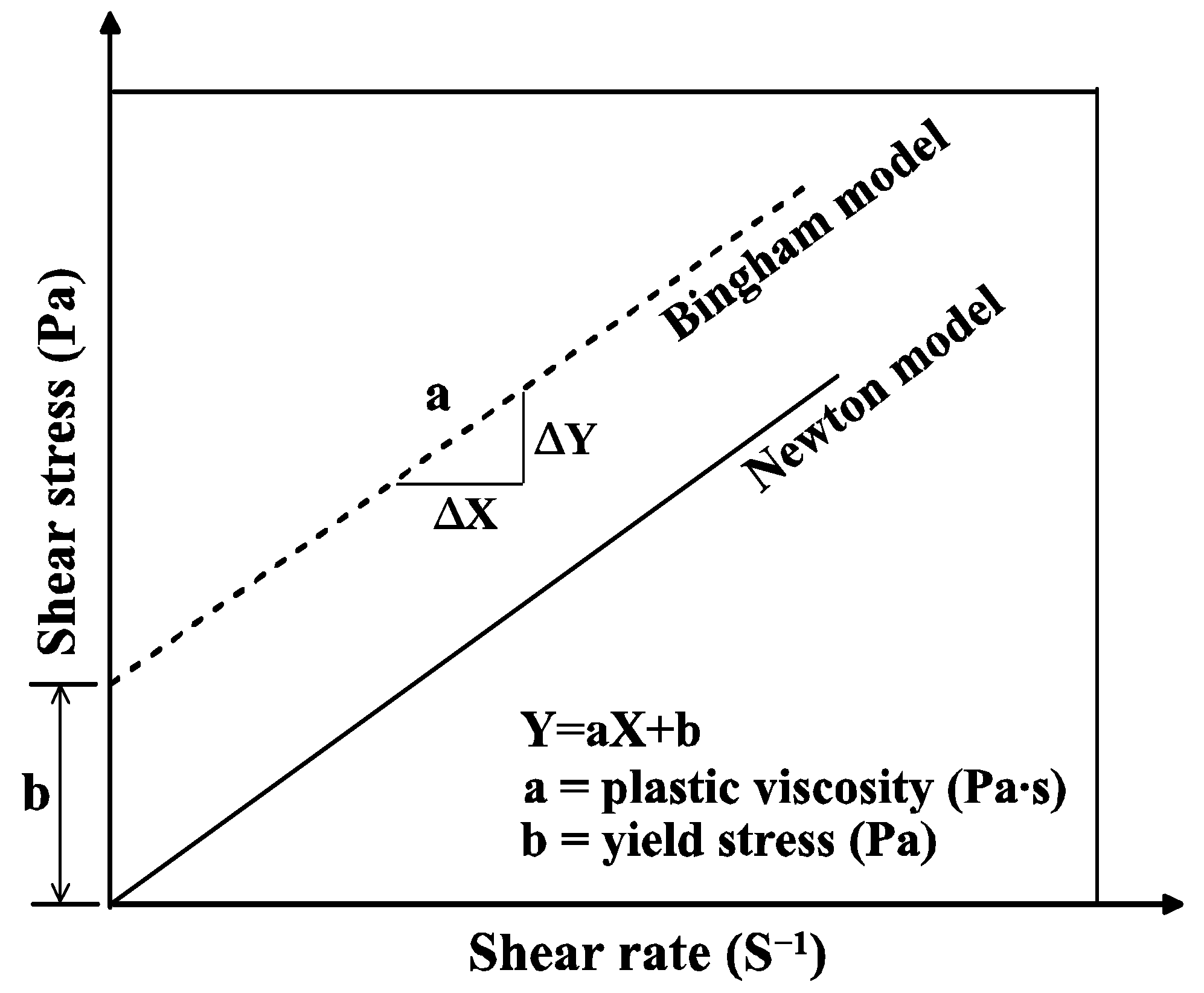

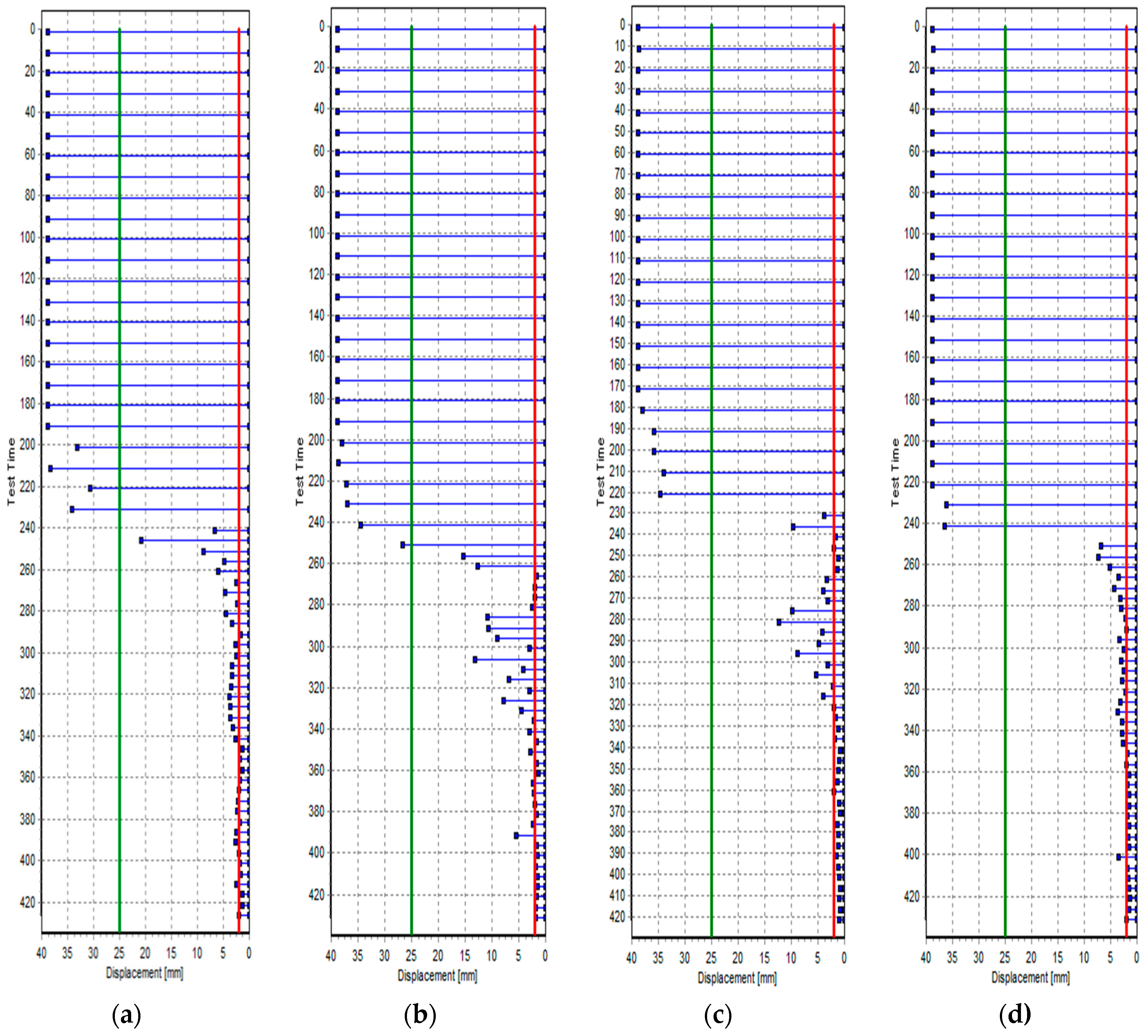
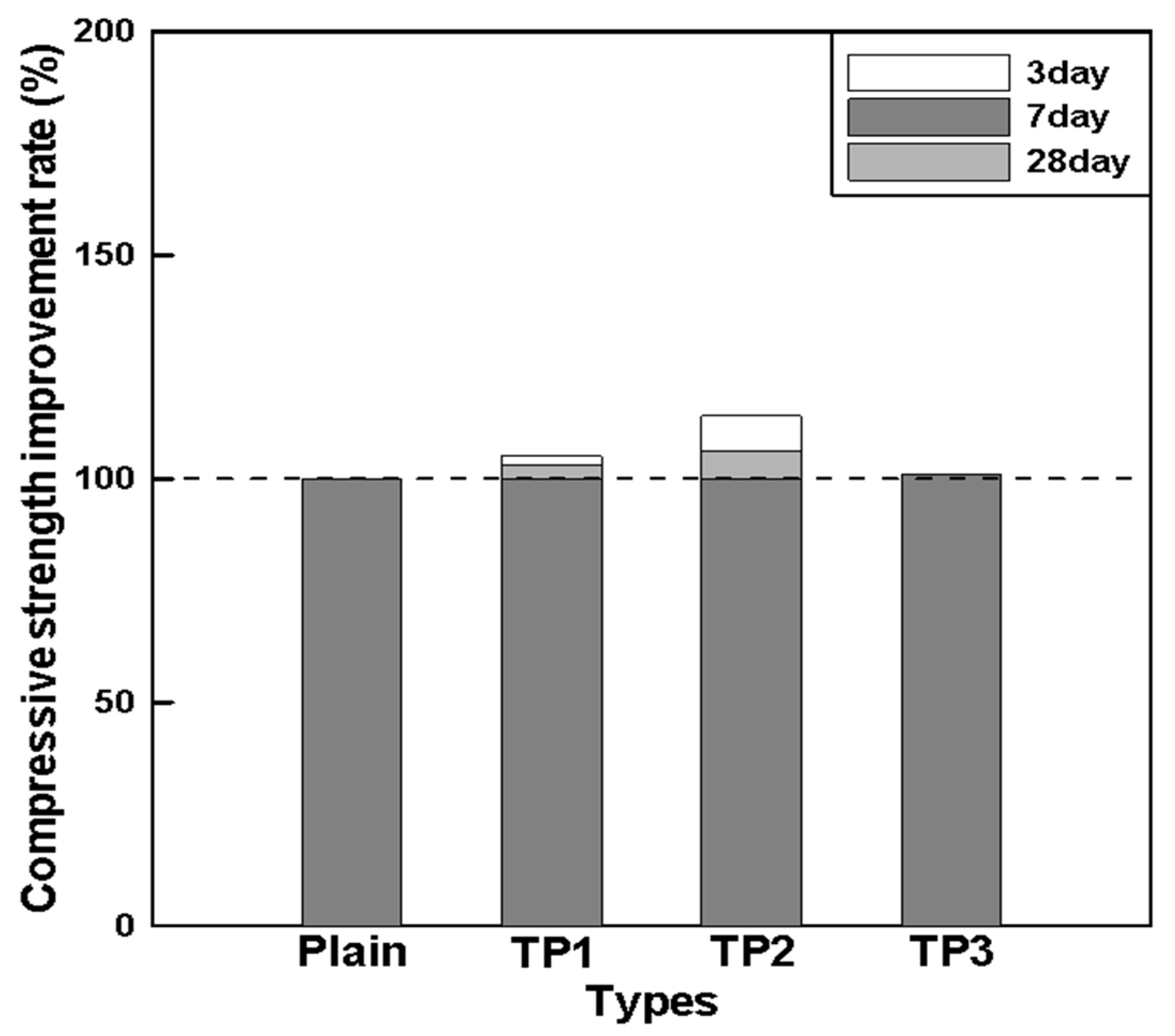
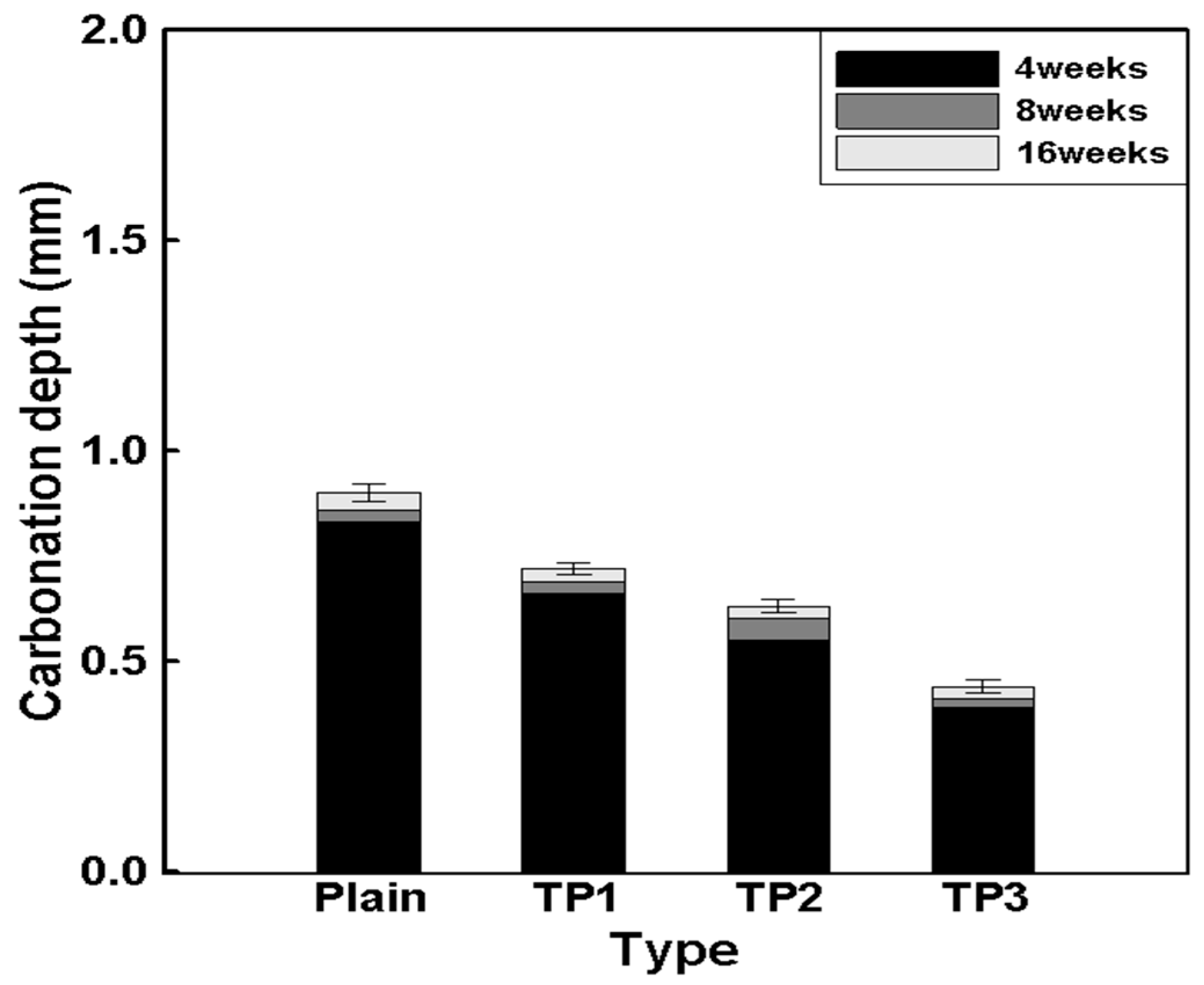
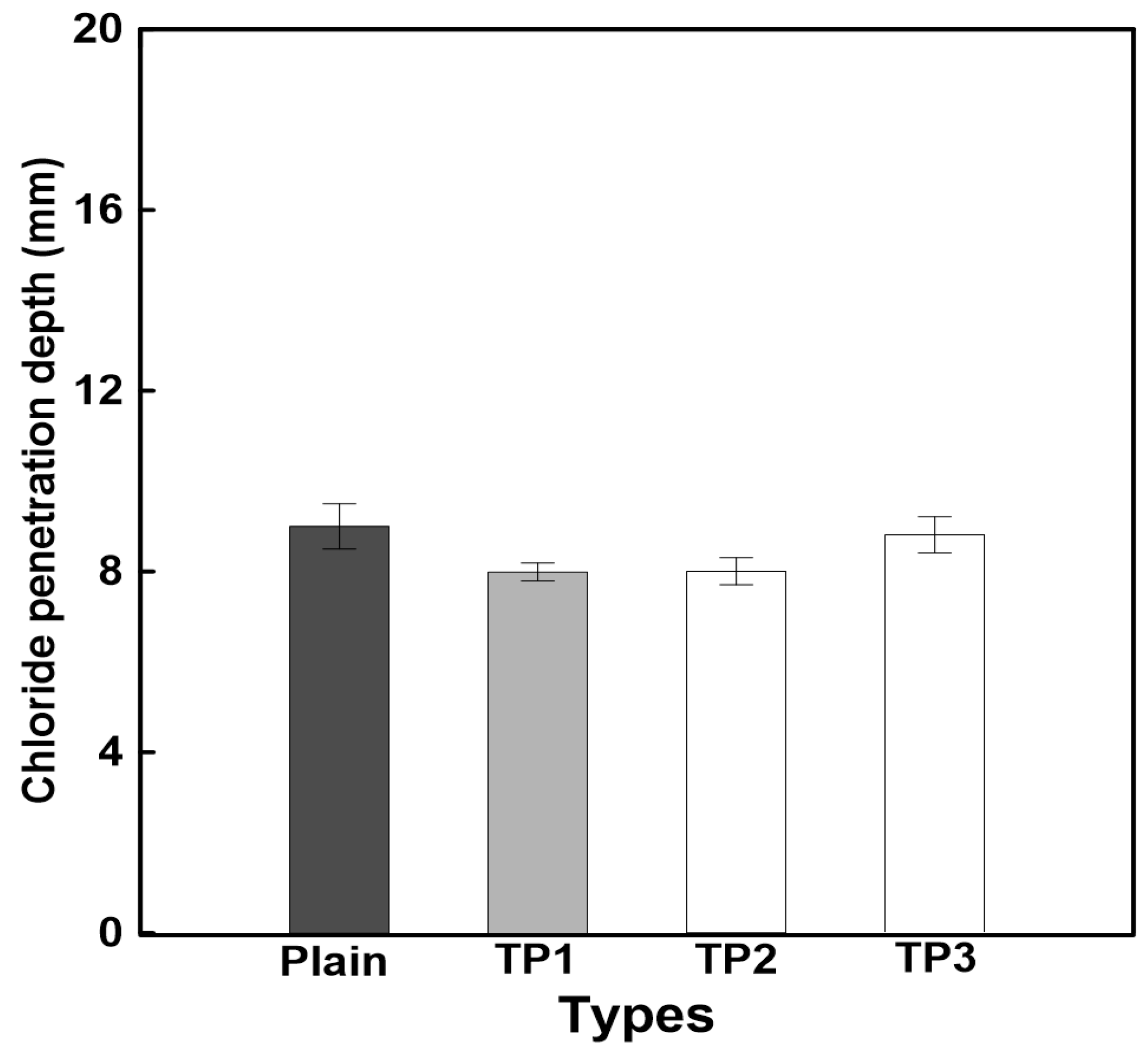
| Type | Item | Evaluation Standard |
|---|---|---|
| Rheological properties | Flow | ASTM C 1437-20 |
| Setting | ASTM C 191-21 | |
| Rheology | Internal Evaluation Criteria Applied | |
| Mechanical properties | Compressive strength | KS L ISO 679 |
| Flexural strength | KS L ISO 679 | |
| Bond strength | ASTM C1585/C1583M-20 | |
| Durability properties | Drying shrinkage | ASTM C157/C157M-17 |
| Carbonation | ASTM C1905/C1905M-23 | |
| Chloride ion penetration resistance | ASTM C 1202-22e1 |
| Type | CaO (%) | SiO2 (%) | Al2O3 (%) | MgO (%) | Fe2O3 (%) | SO3 (%) | L.O.I (%) | Surface Area (cm2/g) | Density (g/cm3) |
|---|---|---|---|---|---|---|---|---|---|
| OPC | 61.40 | 21.60 | 3.40 | 2.50 | 3.10 | 2.50 | 0.03 | 3540 | 3.14 |
| Type | Gmax (mm) | Density (g/cm3) | Absorption (%) | F.M. | Unit Mass (kg/m3) |
|---|---|---|---|---|---|
| S | - | 2.54 | 1.17 | 3.02 | 1739 |
| No. | Water (W) | Binder (B) | Sand (S) | Tapioca Starch (TP) |
|---|---|---|---|---|
| Plain | 0.4 | 1 | 1.5 | - |
| TP1 | 0.4 | 1 | 1.5 | 0.025 |
| TP2 | 0.4 | 1 | 1.5 | 0.050 |
| TP3 | 0.4 | 1 | 1.5 | 0.075 |
| Type | Diameter (μm) | Avg. Diameter (μm) | Amylopectin (%) | Amylose (%) | Density (g/cm3) |
|---|---|---|---|---|---|
| TP | 4–35 | 2 0 | 83 | 17 | 1.6 |
| Mix Type | Plastic Viscosity (Pa·s) | Yield Stress (Pa) | Flow (mm) | ||
|---|---|---|---|---|---|
| 0 min | 30 min | 60 min | |||
| Plain | 32.86 | 165.87 | 210 | 205 | 195 |
| TP1 | 33.92 | 120.51 | 190 | 185 | 182 |
| TP2 TP3 | 37.04 38.41 | 60.26 9.6 | 180 170 | 174 162 | 170 158 |
| Type | Initial Setting Time | Final Setting Time |
|---|---|---|
| Plain | 04:00 | 04:20 |
| TP1 | 04:10 | 04:32 |
| TP2 | 04:15 | 04:40 |
| TP3 | 04:15 | 04:43 |
| Mix Type | Compressive Strength (MPa) | Flexural Strength (MPa) | Bond Strength (MPa) | |||
|---|---|---|---|---|---|---|
| 3 Days | 7 Days | 28 Days | 28 Days | 28 Days | 28 Days | |
| Plain | 27 | 31 | 34 | 7.0 | 7.8 | 1.8 |
| TP1 | 28 | 32 | 34 | 7.3 | 8.0 | 2.0 |
| TP2 | 29 | 33 | 34 | 7.6 | 8.0 | 3.2 |
| TP3 | 27 | 31 | 34 | 7.1 | 7.9 | 1.7 |
| Type | Length Change (10−6 με) | Carbonation Depth | ||
|---|---|---|---|---|
| 28 Days | 4 Weeks | 8 Weeks | 16 Weeks | |
| Plain | −800 | 0.83 mm | 0.86 mm | 0.90 mm |
| TP1 | −750 | 0.66 mm | 0.69 mm | 0.72 mm |
| TP2 | −740 | 0.55 mm | 0.60 mm | 0.63 mm |
| TP3 | −790 | 0.39 mm | 0.41 mm | 0.44 mm |
| Chloride Ion Penetrability Based on Charge Passed | |||
|---|---|---|---|
| Total Passed Charge (Coulombs) | Chloride Ion Penetrability | ||
| >4000 | High | ||
| 2000–4000 | Moderate | ||
| 1000–2000 | Low | ||
| 100–1000 | Very low | ||
| <100 | Negligible | ||
| Type | Total charge | Diffusion coefficient | Decision |
| Plain | 2050.74 | 6.2351 × 10−12 | Moderate |
| TP1 | 1831.68 | 5.6706 × 10−12 | Low |
| TP2 | 1973.25 | 6.0366 × 10−12 | Low |
| TP3 | 1899.99 | 5.8477 × 10−12 | Low |
Disclaimer/Publisher’s Note: The statements, opinions and data contained in all publications are solely those of the individual author(s) and contributor(s) and not of MDPI and/or the editor(s). MDPI and/or the editor(s) disclaim responsibility for any injury to people or property resulting from any ideas, methods, instructions or products referred to in the content. |
© 2024 by the authors. Licensee MDPI, Basel, Switzerland. This article is an open access article distributed under the terms and conditions of the Creative Commons Attribution (CC BY) license (https://creativecommons.org/licenses/by/4.0/).
Share and Cite
Jang, C.-H.; Kim, Y.-J.; Oh, S.-R. Experimental Study on the Effects of Tapioca Starch on Cement Mortar Quality Improvement. Materials 2024, 17, 3889. https://doi.org/10.3390/ma17163889
Jang C-H, Kim Y-J, Oh S-R. Experimental Study on the Effects of Tapioca Starch on Cement Mortar Quality Improvement. Materials. 2024; 17(16):3889. https://doi.org/10.3390/ma17163889
Chicago/Turabian StyleJang, Chang-Hwan, Yong-Jic Kim, and Sung-Rok Oh. 2024. "Experimental Study on the Effects of Tapioca Starch on Cement Mortar Quality Improvement" Materials 17, no. 16: 3889. https://doi.org/10.3390/ma17163889







